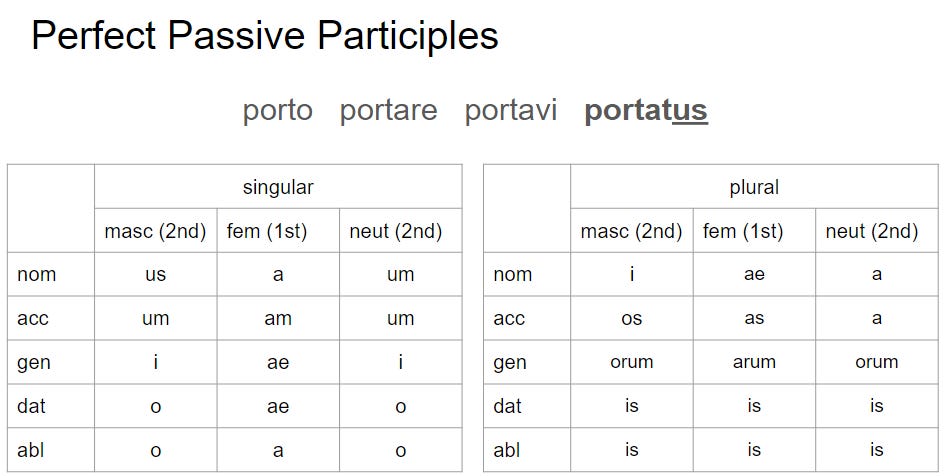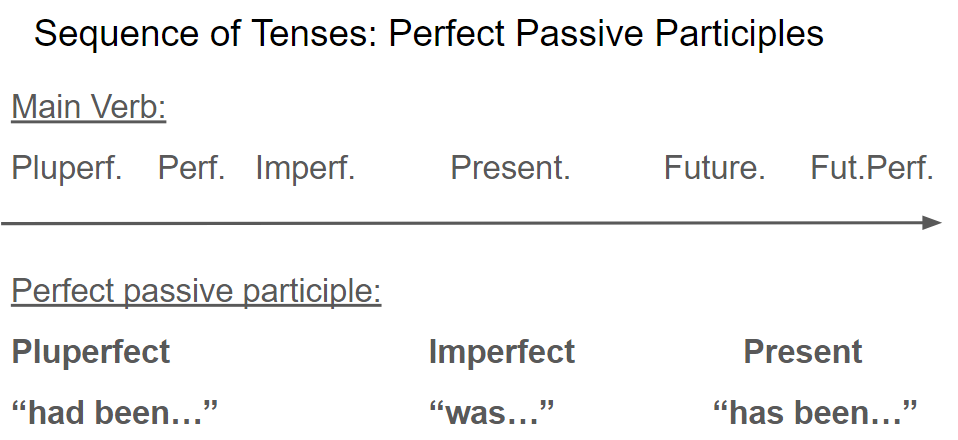Why PPPs are excellent
This is a Perfect Passive Participle fan post
Today is all about perfect passive participles. I think these are excellent, and my task today is to convince you of the same.
Noun Endings are crucial!
Because we're having a look at participles, you really need to know your noun endings.
“Oh no!” you may think, “I can’t remember nouns at all!”
But never fear! I am here to help! If you're struggling with noun endings, please download my free Noun Endings Guide here. It'll really help you out to have it to hand.
First, what is a participle?
Well to really break it down, it's what's called a verbal adjective.
That sounds really confusing, but it basically forms two parts.
It's formed from a verb
It declines like an adjective.
By this, I mean that it has a tense and a voice (like a verb) but it also has a number, gender, and case, like an adjective.
There's quite a few types of participle. I covered the first in my last post, which you can find here, and future posts will be about the others. Make sure you’re subscribed to get that sent straight to your inbox!
There are several types of participle in Latin. Here is a quick summary:
present active participle: “carrying”
Example: the man carrying the books.
perfect passive participle: “having been carried”
Example: he put down the having been carried books.
future active participle: “about to carry”, or “being about to carry”.
Example: being about to carry the books, he stretched his arms.
perfect active participle: “having spoken”.
These are only for deponent verbs
This post is about the perfect passive participle, having been carried. That's how we're going to translate them.
Here's what you need to know
How is it verbal?
Perfect Passive Participles (or PPPs) are formed from the fourth principal part of a verb. What that means is when you open your dictionary and you find a verb, you usually get four different parts. If you have forgotten, or want a reminder of what the principal parts in Latin are, read Day 20 of the January Latin Challenge: The Importance of Principal Parts. This fourth principal part gives us the verb bit of the “verbal adjective” description I used before.
Here are the four principal parts of the verb “to carry”:
porto, portare, portavi, portatus.
The fourth one is the one we’re interested in today, the perfect passive participle. Because our dictionaries don't go on forever, and thank goodness they don't because we wouldn't be able to carry them around if they did, we only get given the singular masculine nominative version of our perfect passive participle. However, there are many endings that it can have.
But don't stress out! Remember how I said they go like 2-1-2 adjectives?
Now for the adjective qualities
A PPP matches the noun it's describing in case, number, and gender. Remember above we said it's like an adjective? This is why. It declines like a 2-1-2 adjective. We'll have a look at the endings, so don't worry, but if you can't remember what a 2-1-2 adjective is, you can read my post about them here.
It has masculine, feminine, and neuter endings, so it has -us, -a, -um, and all the cases that go with those. It needs to have all these endings so that it can match any noun in any case.
Their form can be boiled down to this:
If we want to change the case, number or gender, take the -us off portatus, and add on any of these endings.
The second declension masculine endings are the endings that match masculine nouns.
The first declension endings are for feminine endings.
The second declension neuter endings go for to match neuter nouns.
So if the adjective is describing the woman carrying the books and she's nominative I use -a. If she's accusative I use -am. If it's “to” the woman carrying the books then I would use -ae because that's my dative ending, and so on.
If we want to talk about more than one person or thing, we need plural endings. So again, just use the 2-1-2 endings: second declension, first declension, and second declension neuter.
Don't worry if you can't remember all of these, you can go and download the Nouns Reference Guide here which has all of those written out for you to keep to hand.
What are they for?
A perfect passive participle describes an action that's already in the past by the time the main verb comes along, and it is linked to a noun. That's all that a participle really does. It gives you more information about the noun it's describing, just like an adjective does. In this case, it's just formed from a verb, so it has slightly more information attributed to it.
Look at this sentence:
servus vocatus timebat.
Having been called, the slave was afraid.
servus is nominative. He's in charge of the sentence, “the slave”.
Then the verb, timebat, “was fearing”, or “was afraid”.
Then I get a little bit more information about the slave. In this case, vocatus, “having been called”. This action has already occurred before the slave felt afraid.
Literally, this could be translated as, “the-having-been-called-slave was afraid”.
That is perfectly fine. That would get you full marks. However, it's a bit clunky.
So what I'm going to say is, “having been called, the slave was afraid”. I could also change this to “after he had been called, the slave was afraid” or “when he had been called, the slave was afraid”. All of these would be acceptable.
Sequence of Tenses
Something important to remember when you're doing participles is something called the sequence of tenses. Remember how I said above that the main verb really dictates how to translate the participle, which tense to translate it in? Well, this is how this works. It’s a bit confusing to look at, so I’ll explain it below.
There are three categories of main verb:
Past tenses: pluperfect, perfect, and imperfect.
Present tense
Future tenses: future and future perfect
These three distinct categories dictate how to translate the perfect passive participle.
If a main verb is one of the past tenses (pluperfect, perfect or imperfect) you have to take another step back in time for the PPP, because my participle has already happened by the time the main verb happens. If the main verb is one of the past tenses, I need to translate the participle as if it is a pluperfect, “had been”.
When he had been called, the slave was afraid.
If the verb is present, you have to translate it as an imperfect. Again, this is because the PPP needs to take a step back from the present, so you translate it as “was” or “were”.
Since he was called, the slave is afraid.
If the main verb is future or future perfect, again take a step back, this time it goes to the present tense. So, has been.
When he has been called, the slave will fear.
That’s PPPs!
And that's really all there is to know about perfect passive participles. They sound quite complicated, but as long as you remember that it's the fourth principal part and then those endings from your 2-1-2 adjectives, they actually become really easy to spot.
These ones are my favourite participle because I think they're the easiest to spot, they're the most interesting to talk about, and they're the most interesting to translate!
If I see a perfect passive participle, I think, “oh yeah, perfect, I know exactly what's going on here”. The main thing is to translate them fluently so that you try and keep that perfect passive sense. Take a step back in time from your main verb, because the participle has already been completed.
See you next time!
Thank you so much for reading! I hope it's been useful. Let me know what you think in the comments, and I'll see you next time on bambasbat.



